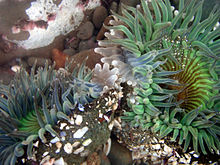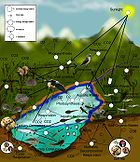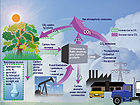- Competition (biology)
-
 Sea Anemones compete for the territory in tide pools
Sea Anemones compete for the territory in tide pools
Competition is an interaction between organisms or species, in which the fitness of one is lowered by the presence of another. Limited supply of at least one resource (such as food, water, and territory) used by both is required.[1] Competition both within and between species is an important topic in ecology, especially community ecology. Competition is one of many interacting biotic and abiotic factors that affect community structure. Competition among members of the same species is known as intraspecific competition, while competition between individuals of different species is known as interspecific competition. Competition is not always straightforward, and can occur in both a direct and indirect fashion.[2].
According to the competitive exclusion principle, species less suited to compete for resources should either adapt or die out. According to evolutionary theory, this competition within and between species for resources plays a critical role in natural selection, however, competition may play less of a role than expansion among larger groups such as families.[2].
Contents
Types of competition
By mechanism
The following terms describe mechanisms by which competition occurs, which can generally be divided into direct and indirect. These mechanisms apply equally to intraspecific and interspecific competition.
- Interference competition
- Occurs directly between individuals via aggression etc. when the individuals interfere with foraging, survival, reproduction of others, or by directly preventing their physical establishment in a portion of the habitat.
- Exploitation competition
- Occurs indirectly through a common limiting resource which acts as an intermediate. For example, use of resources depletes the amount available to others, or they compete for space. Also known as exploitative competition.
- Apparent competition
- Occurs indirectly between two species which are both preyed upon by the same predator. For example, species A and species B are both prey of predator C. The increase of species A will cause the decrease of species B because the increase of As would increase the number of predator Cs which in turn will hunt more of species B.
By species
Intraspecific competition
Main article: Intraspecific competitionIntraspecific competition occurs when members of the same species vie for the same resources in an ecosystem. For example, two trees growing close together will compete for light above ground, and water and nutrients in the soil. Therefore, getting less resources, they will usually perform less well than if they grew by themselves. Although in this situation it may actually be more useful to think in terms of resource availability than competition. Adaptations to such an environment include growing taller, (where the specific prediction provided by the competition model is that all species in such a situation will grow as tall as possible). or developing a larger root system (where the specific prediction is that all species in the system will develop very deep root systems). The real question is whether these predictions are evidenced by our observations of the natural world...
Interspecific competition
Main article: Interspecific competitionInterspecific competition may occur when individuals of two separate species share a limiting resource in the same area. If the resource cannot support both populations, then lowered fecundity, growth, or survival may result in at least one species. Interspecific competition has the potential to alter populations, communities and the evolution of interacting species.
An example among animals Joe Pa could be the case of cheetahs and lions; since both species feed on similar prey, they are negatively impacted by the presence of the other because they will have less food, however they still persist together, despite the prediction that under competition one will displace the other. In fact, lions sometimes steal prey items killed by cheetahs. Potential competitors can also kill each other, and this phenomenon is called 'intraguild predation'. For example, in southern California coyotes often kill and eat gray foxes and bobcats, all three carnivores sharing the same stable prey (small mammals).[3]
Competition has been observed between individuals, populations and species, but there is little evidence that competition has been the driving force in the evolution of large groups. For example, between reptiles and mammals. Mammals lived beside reptiles for many millions of years of time but were unable to gain a competitive edge until dinosaurs were devastated by the K-T Extinction[2].
Evolutionary strategies
Main article: r/K selection theoryIn evolutionary contexts, competition is related to the concept of r/K selection theory, which relates to the selection of traits which promote success in particular environments. The theory originates from work on island biogeography by the ecologists Robert MacArthur and E. O. Wilson.[4]
In r/K selection theory, selective pressures are hypothesised to drive evolution in one of two stereotyped directions: r- or K-selection[5]. These terms, r and K, are derived from standard ecological algebra, as illustrated in the simple Verhulst equation of population dynamics:[6]
where r is the growth rate of the population (N), and K is the carrying capacity of its local environmental setting. Typically, r-selected species exploit empty niches, and produce many offspring, each of whom has a relatively low probability of surviving to adulthood. In contrast, K-selected species are strong competitors in crowded niches, and invest more heavily in much fewer offspring, each of whom has a relatively high probability of surviving to adulthood.
See also
- Biological interaction
- Character displacement
- Minimum viable population
- Resource (biology)
- Resource partitioning
References
- ^ Begon, M.; Harper, J. L.; Townsend, C. R. (1996) Ecology: Individuals, populations and communities Blackwell Science.
- ^ a b c Sahney, S., Benton, M.J. and Ferry, P.A. (2010). "Links between global taxonomic diversity, ecological diversity and the expansion of vertebrates on land" (PDF). Biology Letters 6 (4): 544–547. doi:10.1098/rsbl.2009.1024. PMC 2936204. PMID 20106856. http://rsbl.royalsocietypublishing.org/content/6/4/544.full.pdf+html.
- ^ .Fedriani, J. M., T. K. Fuller, R. M. Sauvajot and E. C. York. 2000. Competition and intraguild predation among three sympatric carnivores. Oecologia, 125:258-270.
- ^ MacArthur, R. and Wilson, E. O. (1967). The Theory of Island Biogeography, Princeton University Press (2001 reprint), ISBN 0-691-08836-5M.
- '^ Pianka, E. R. (1970). On r and K selection. American Naturalist '104, 592-597.
- '^ Verhulst, P. F. (1838). Notice sur la loi que la population pursuit dans son accroissement. Corresp. Math. Phys. '10, 113-121.
Inter-species biological interactions in ecology Amensalism • Commensalism • Inquilinism • Mutualism • Neutralism • Synnecrosis • Predation (Carnivory • Herbivory • Intraguild • Parasitism • Parasitoidism • Cheating) • Symbiosis • Competition • MimicryCategories:- Competition
- Biological interactions
Wikimedia Foundation. 2010.




